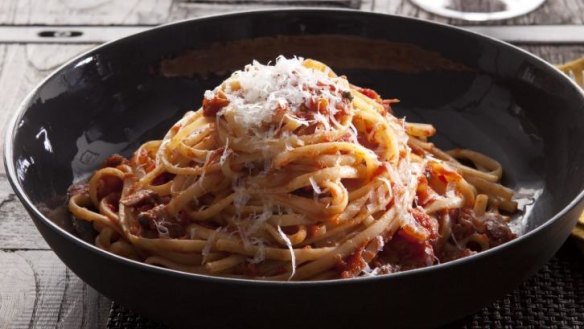Brain Food: Why is my pasta a sticky mess?

I live in a share house and my flatmates don't like my pasta saying it sticks together. K. Lyons
Italian chef, raconteur and philosopher Stefano de Pieri has a beautiful way of describing cooking. "Pasta is a thirsty ingredient," he once told me. "You must give it plenty to drink to come alive in the pot. And you can't do this in a small saucepan." Pasta absorbs twice its dry weight in water during cooking, making it swell and soften, while releasing starch into the water. I suggest you try a larger saucepan. (You might find a cheap five or 10-litre stockpot in an op shop.) Never rinse pasta. Keep a little cooking water aside and marry the sauce and pasta together in the pasta pot adding a little reserved cooking water if the sauce is too dry.
I like microwaving vegies on a plate covered with cling film. Is it safe? L. Sing
If you try and breathe through it? No. As a method of birth control? No. As a cooking medium? If used as directed, then the health authorities say yes. Health authorities suggest not letting the cling film touch the food. Cling film (brand names such as Glad Wrap) is a made from PVC. Some brands are also made with a compound called diethylhexyl phthalate (DEHP) that makes the wrap more "plastic". Small amounts of these compounds can migrate to food especially when heated. The Federal Department of Health states that DEHP has the potential for adverse health effects – particularly reproductive effects – from exposure to DEHP leaching from products. It is advised that when using cling film that it not come into contact with food and that there is a vent or holes for the steam to escape. On a similar matter a recent survey of food packaging by Food Standards Australia and New Zealand looked at 30 compounds used in food packaging and that half produced no residue in food. Very low levels of residues of DEHP were found in some samples, such as peanut butter. It was stated by one expert that a person would have to eat about600g of the sampled pizza a day for it to be of concern.
We had a pizza party on New Year's Eve and some of the leftover dough was put in the fridge. The next day it smelled like beer. Is that OK? T. Jacobs
I often find that things in my fridge smell like beer on New Year's Day only to discover it is my own breath. Although yeast prefers to work at a nice warm temperature of about 27C it will continue to ferment, albeit very slowly, in the fridge. That beery smell is the trapped aromas of fermentation, one of which is the alcohol. During fermentation the yeast breaks down the starch in flour into simple sugar and then digests the sugar. The carbon, hydrogen and oxygen in the sugar are reformulated by the yeast into CO2, water and alcohol. During baking the alcohol vaporises helping make the dough light and spongy. You won't get your guests drunk but I do like your suggestion of creating the "beer crust pizza".
Send your vexing culinary conundrums to brainfood@richardcornish.com.au or tweet @Foodcornish
The best recipes from Australia's leading chefs straight to your inbox.
Sign up